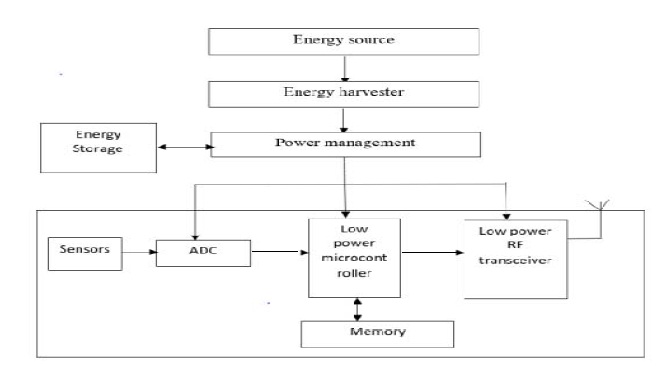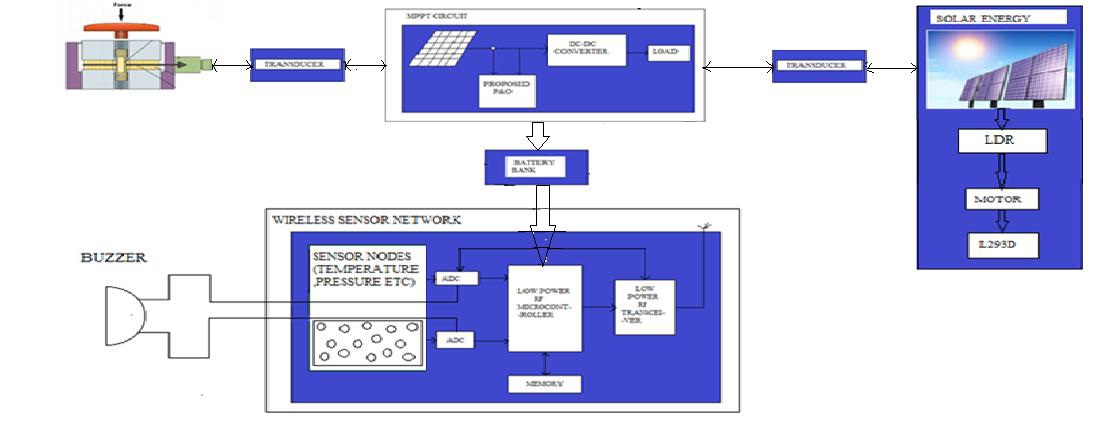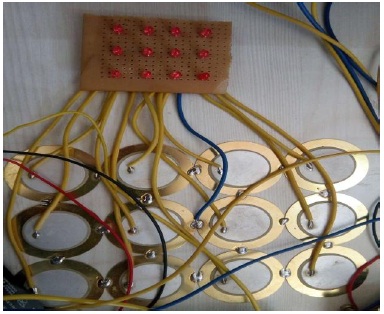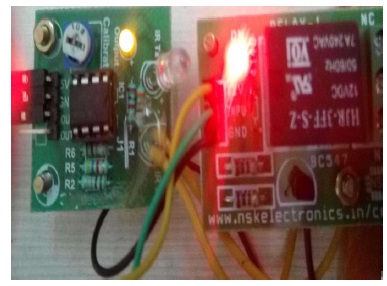





Published on Nov 30, 2023
In Wireless sensor networks, need of energy harvesting in devices are rapidly increasing day by day due to large amount of use. Wireless Sensor Networks (wsns) are used to transmit physical or environmental conditions such as temperature, humidity etc. to base station. It depends on batteries which needs to be recharged or replaced because they provide limited energy and as the size of networks is keep growing it seems very impractical to replace batteries in such a large network.. Lifetime of wireless sensor networks can be increased by improving its energy efficiency and lot of research work has been performed related to this. Wireless sensor networks are used for monitoring and recording conditions at different locations. In this project, various types of MPPT algorithms are discussed.
A piezoelectric substance is one that produces an electric charge when a mechanical stress is applied (the substance is squeezed or stretched).Conversely, a mechanical deformation (the substance shrinks or expands) is produced when an electric field is applied. This effect is formed in crystals that have no centre of symmetry. In order to produce the piezoelectric effect, the polycrystal is heated under the application of a strong electric field. The heat allows the molecules to move more freely and the electric field forces all of the dipoles in the crystal to line up and face in nearly the same direction
Energy harvesting or energy scavenging is the process of extracting small amount of energy from ambient environment through various sources of energy. The available energy for harvesting is mainly provided by ambient light (artificial and natural lighting), ambient radio frequency, thermal sources and mechanical sources. Reduction in size and energetic demands of sensors, and the low power consumption trend in CMOS electronic circuitry opened novel research lines on battery recharge via available power ources. Harvesters can be employed as battery rechargers in various environments, such as industries, houses , the military (as for unmanned aerial vehicles) and handheld or wearable devices . The possibility to avoid replacing exhausted batteries is highly attractive for wireless networks (Wireless Sensor Networks), in which the maintenance costs due to battery check and replacement are relevant. Another emerging field of application is biomedical systems, where the energy could be harvested from an off-the-shelf piezoelectric unit and used to implement drug delivery systems or tactile sensors. Recent research also includes energy conversion from the occlusal contact during chewing by means of a piezoelectric layer and from heart beats.
Currently, there is a need to utilize alternative forms of energy at passenger terminals like airports and railways across the world. Cleaner, more sustainable forms of electrical power are needed in order to keep costs lower, to maintain positive and productive relationships with neighbours and to insure a healthier environment for future generations. The use of piezoelectric devices installed in terminals will enable the capturing of kinetic energy from foot traffic. This energy can then be used to offset some of the power coming from the main grid. Such a source of power can then be used to operate lighting systems. The increasing prevalence and portability of compact, low power electronics requires reliable power sources. Compared to batteries, ambient energy harvesting devices show much potential as power sources.A piezoelectric generator can be developed that harvests mechanical vibrations energy available on a bicycle. The electrical energy thus produced can be used to power devices aboard the bike, or other portable devices that the cyclist uses. Electrical energy can also be generated from traffic vibrations (vibrations in the road surface) using piezoelectric material.
To study and understand Wireless Sensor Network (WSN).
To analyze working of WSN and its advantages in real-time applications.
To find importance of energy harvesting in WSN.
To find various methods of maximum energy harvesting in WSN.
To design a method for maximum energy harvesting using WSN.
The energy harvesting is the branch of the energy management, where the energy is being originated from the multiple sources. The energy harvesting is usually done from the sources such as wind mills, solar cells, piezoelectric and other similar power generation modules. In this project, the energy harvesting methods are discussed for the wireless sensor networks. In this model, energy harvesting setup focuses upon the controlled release of the energy required to run the basic operations on each sensor device. The energy estimation is performed to estimate the amount of energy. Maximum power point tracking (MPPT) is utilized to obtain the maximum power output from the source of the energy. The proposed approach is aimed at gaining the maximum benefit from the energy harvesting model to facilitate the continuous WSN operations. In this project various MPPT algorithms are compared, analyzed and finally tabulated to get maximum insight.

Sensors
Battery
Solar panel
Piezoelectric sensors
Wires
Kiel vision 4



Piezoelectric energy harvesting is a very interesting concept, in present day life, where there is a great demand for energy; it is best suitable and also very efficient way of energy harvesting. Piezo ceramic converts the mechanical stress applied on it into electrical energy. This electrical energy is further stored in a device like lithium polymer batteries so that it can be used in portable devices such as mobile phones or other hand held electrical devices. It is very reliable as it uses the movement of man such as walking, jogging etc, to produce energy. The Transducer AC–DC converter and battery charging circuit used in the project contains minimum number of components and hence it is very compact, low cost and the future changes can be made without much difficultly in the hardware. The inclusion of further components in the circuit can be made easily. Piezoelectric energy harvesting is one of the most reliable and energy efficient method. The crystalline structure of piezoelectric materials provides the ability to transform mechanical strain energy into electrical energy.
Energy estimation is very important for energy harvesting equipment’s and MPPT algorithms take care of that. In this project, this model focuses on power source based upon piezoelectric energy harvester. MPPT aimed to solving the issue of continuous energy by storing surplus energy in the backup battery, which is utilized to given power to wireless sensor networks. Energy estimation methods calculate the basic amount of energy by multiplying the energy required by each node and no. Of nodes needs to power up to run the WSN operations. The special operation request is send to the power assignment module, which is used to allocate the extra amount of energy for the specific overhead operations by a sensor node. The expected outcome is calculated in the form of output power and contiguous uptime of the wireless sensor network. Also the number of WSN rounds can be estimated along with the contiguous uptime for each round.
[1] BBC News. (2006, October 23). The Cost of Lighting the World.Retrieved December.
[2] Cutraro, J. (2007, July 31). Little Treadmills Everywhere: Floors That Harvest the Energy in Every Step. International Herald Tribune
[3] Gaylord, C. (2007, September 26). Power Harnessed One Step at a Time. Retrieved December 1, 2008, from The Christian Science Monitor.
[4] Leinonen M., Palosaari J., Juuti J., Jantunen H.: Piezoelectric energy harvester for vibrating environments using multiple beam topology for wideband operation, Suomen automaatioseura, AP XIX 2011 Proceedings, vol41 (2011).
[5] http://en.wikipedia.org/wiki/Piezoelectricity